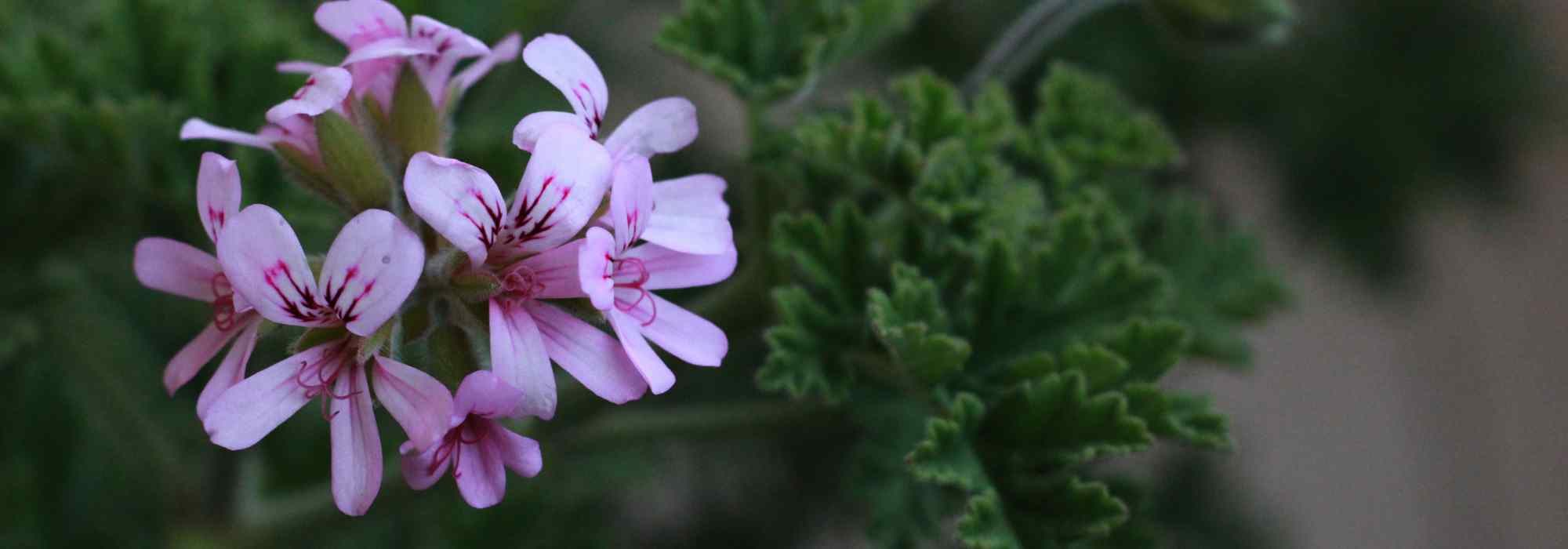
Diseases and parasitic pests of pelargoniums
Identification, prevention and natural solutions
Contents
Geraniums, or Pelargoniums in Latin, are among the essential plants for gardens, terraces or balconies. Their colourful flowers provide a spectacle from late spring until the first frosts. Although considered easy to grow and low-maintenance, pelargoniums can nevertheless be susceptible to certain diseases or suffer from parasitic attacks. Let’s look at the most common issues, how to prevent risks and apply natural treatments if needed.
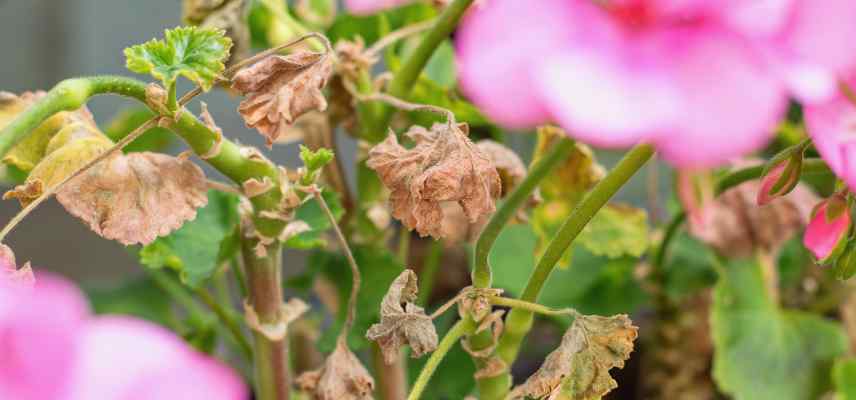
Pelargoniums can be affected by several diseases that cause their foliage to suddenly dry out
Fungal diseases
Identification
Fungal diseases are caused by fungi. They are the most common in the garden, so you’ve likely encountered them before. They are often encouraged by a combination of heat and moisture, which is why they can appear as early as spring in some regions. They have the unfortunate tendency to quickly contaminate nearby plants, aided by wind, gardeners, poorly disinfected pruning tools, insects, etc. Additionally, spores can remain in the soil for a long time and aren’t necessarily destroyed by winter cold.
Regarding our pelargoniums, the most widespread is botrytis, also known as “grey mould”. One of the symptoms of this disease is the development of brown spots covered with a dusty-looking grey fuzz. It first appears at the base of the stems, then on the leaves and flowers. If the disease develops in late summer, it’s not necessarily serious since balcony geraniums are often grown as annuals. However, the disease can also appear in spring, which may then affect the plant’s growth. The flowers will wilt, sometimes even at the bud stage, and the foliage will drop. Eventually, the entire pelargonium may become necrotic.
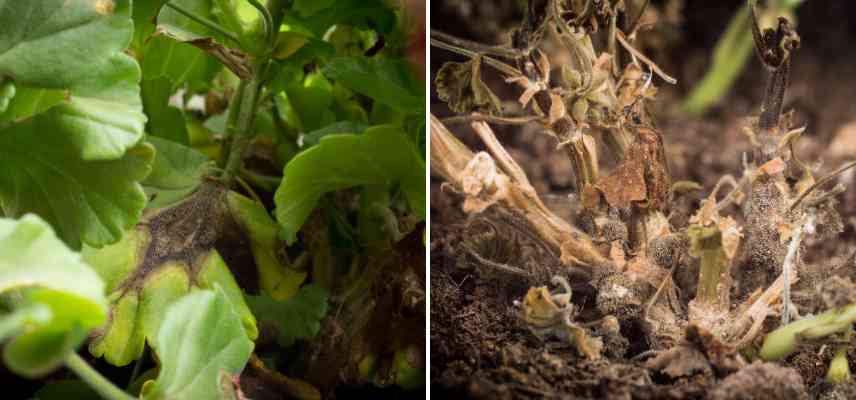
The Pelargonium gradually becomes completely necrotic if left untreated
Rust is another fungal disease that can affect pelargoniums. It is recognised by powdery orange, yellow, or brown pustules that appear on the foliage. These blister-like spots later burst to spread spores to surrounding plants. You’ll also notice that your geranium leaves dry out and fall prematurely. The plant will stop growing and may eventually die.
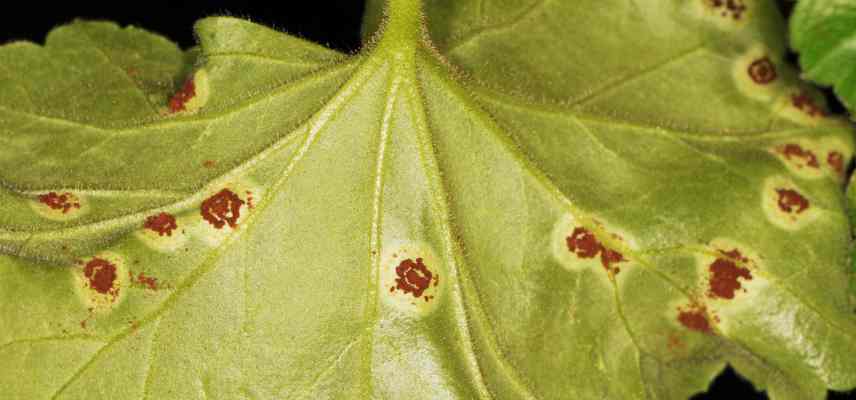
Rust is easily identifiable
Prevention and Solutions
For fungal diseases, preventive measures are preferable. Curative treatments are not always effective, especially if the disease is already well-established.
- Ensure optimal growing conditions for your pelargoniums. Healthy plants are more resistant to diseases. Whether in the ground or in pots, note that they prefer soil rich in organic matter and light (well-drained), in sunny or partially shaded positions in the hot regions of southern France. In pots, to avoid water stagnation around the roots, always choose containers with drainage holes and add a 3 to 5 cm layer of drainage material at the bottom (such as gravel, river sand, or clay pebbles).
- If you prune your pelargoniums, for example to remove damaged leaves or spent flowers, always disinfect your cutting tools with alcohol beforehand. This reduces the risk of spore transmission between plants.
- Manage watering correctly. Avoid wetting the foliage and apply an organic mulch around the base of the geraniums. This helps reduce evaporation and keeps the soil moist for longer.
- Respect planting distances. This ensures good air circulation between plants, preventing moisture buildup. Allow about 20 cm between two plants.
- Moderate fertiliser use. Excess nitrogen can weaken the plant and make it more susceptible to diseases and parasites. For flowering plants, opt for a specific fertiliser, rich in potassium.
- Do not plant pelargoniums in previously contaminated soil. As mentioned, spores can survive in the soil for a long time.
If you notice symptoms of a fungal disease, immediately remove the affected parts and dispose of them properly. Then, thoroughly clean your cutting tools.
Both preventively and curatively, nettle and horsetail teas are believed to have fungicidal properties and may help strengthen plants’ immune defences. You can find these in stores or make your own by following our tutorials (how to make nettle tea or horsetail tea).
Bordeaux mixture is also recognised as a fungicide, effective against certain fungal diseases. This copper-based treatment is particularly useful against grey mould. It works best as a preventive measure or at the very early stages of the disease. It is applied by spraying onto affected areas. However, ensure you follow dosage instructions carefully and avoid overuse. While this product remains controversial, it’s because copper is not biodegradable and can contribute to soil imbalance or even pollution.
For further reading, check out our articles:
- All about fungal diseases
- Botrytis or grey mould
- Rust
- Bordeaux mixture and other copper-based garden treatments
Read also
Choosing a pelargoniumThe geranium butterfly
Identification
The stems of pelargoniums can fall victim to the appetite of a small brown butterfly’s caterpillar, called the “geranium bronze” or “geranium lycaenid” (Cacyreus marshalli in Latin). It can quickly cause the death of the plant.
The caterpillar is green and pink, with white hairs. The butterfly is quite small, in uneven brown tones.
The first symptoms are noticeable on the stems which are mined (the caterpillar digs tunnels in them) and on the leaves which are holed.
Ivy-leaved pelargoniums would be more targeted by this little pest, whereas the scented species would be less appealing.
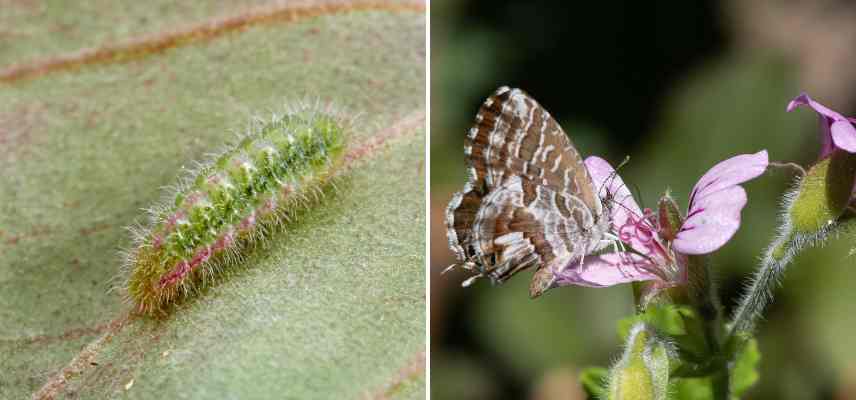
Cacyreus marshalli: caterpillar and butterfly
Prevention and Solutions
Regular observation remains the best prevention. If you have noticed the presence of caterpillars, the simplest and most natural solution, though time-consuming, is to remove them by hand. Similarly, if you spot small solitary white eggs, it is very likely that they belong to the butterfly.
As a preventive measure, try tansy manure, a plant prized for its action against harmful insects, due to its powerful aroma. Check out our tutorial: How to make tansy manure?.
For treatment, there are insecticides based on Bacillus thuringiensis, as for the fight against box tree moth. Additionally, discover our article: Bacillus thuringiensis: a natural insecticide.
Whiteflies or white flies
Identification
The presence of whiteflies is easily noticeable: as soon as you approach an infested plant, a cloud of tiny insects takes flight, only to settle again moments later. Like aphids or scale insects, whiteflies feed on the sap of the plant. Their presence will initially weaken it, but over time, it may lead to the decline of pelargoniums. Worse still, by secreting honeydew, whiteflies encourage the development of a fungal disease called “sooty mould”. It can be identified by the black, soot-like spots that appear beneath the foliage. Lastly, whiteflies can facilitate the spread of viruses by creating entry points for other pathogenous agents.
These small pests reproduce very quickly and thrive in warm conditions. This is why they are commonly found in greenhouse or conservatory cultivation.
Whiteflies are small (about 3 mm long), have two pairs of wings, and are covered in a white powdery substance, which explains their alternative name.
Prevention and Solutions
As a preventive measure for indoor cultivation, you can trap adult whiteflies using yellow sticky strips. However, this solution is not selective: other harmless insects may also get trapped.
Once again, nettle or tansy sprays are said to have repellent properties against these small pests.
At the first signs of infestation, spray a natural insecticidal solution made with black soap. You can easily make this yourself. Be sure to use pure black soap. Dilute 1 tablespoon in 1 litre of warm water. Pour into a spray bottle. Shake well, then treat the affected plants. Note that, even though natural, this treatment is not selective. It is best applied in the evening to minimise the risk of harming other non-harmful insects.
Rose geranium essential oil (Pelargonium X asperum) is also believed to act as an effective insecticidal against whiteflies. To use it, mix 20 drops into a litre of water and spray onto the affected leaves.
To learn more, check out our article: Whitefly: Identification and Treatment.
- Subscribe!
- Contents
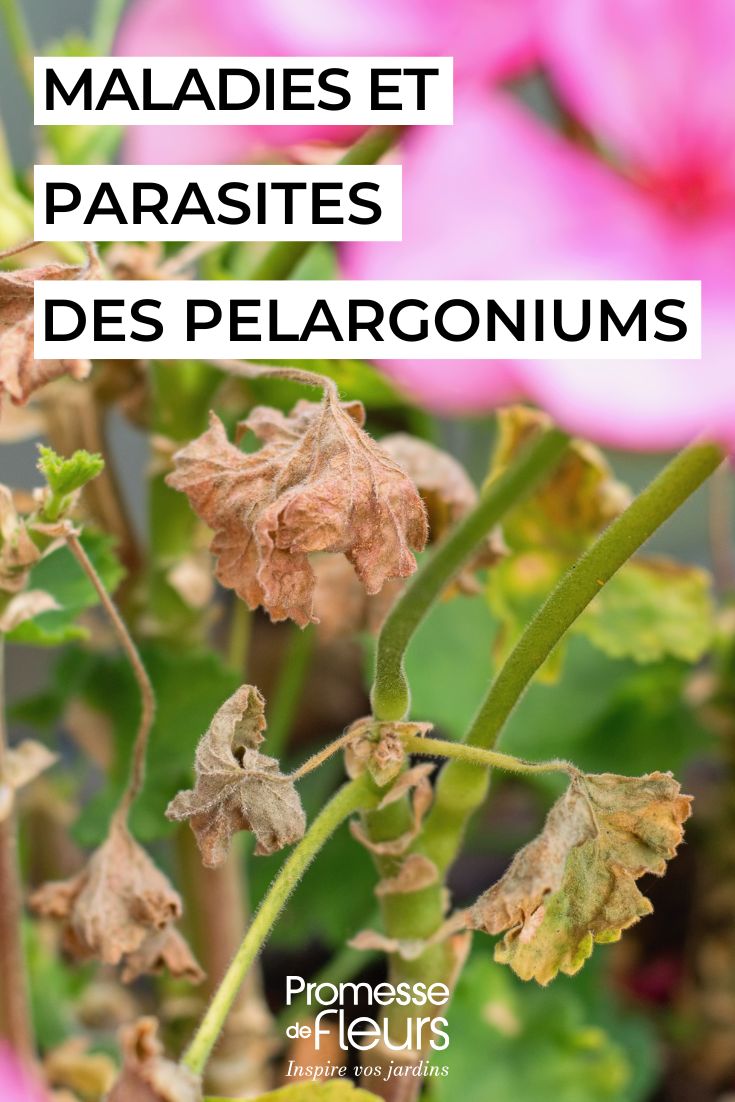































Comments